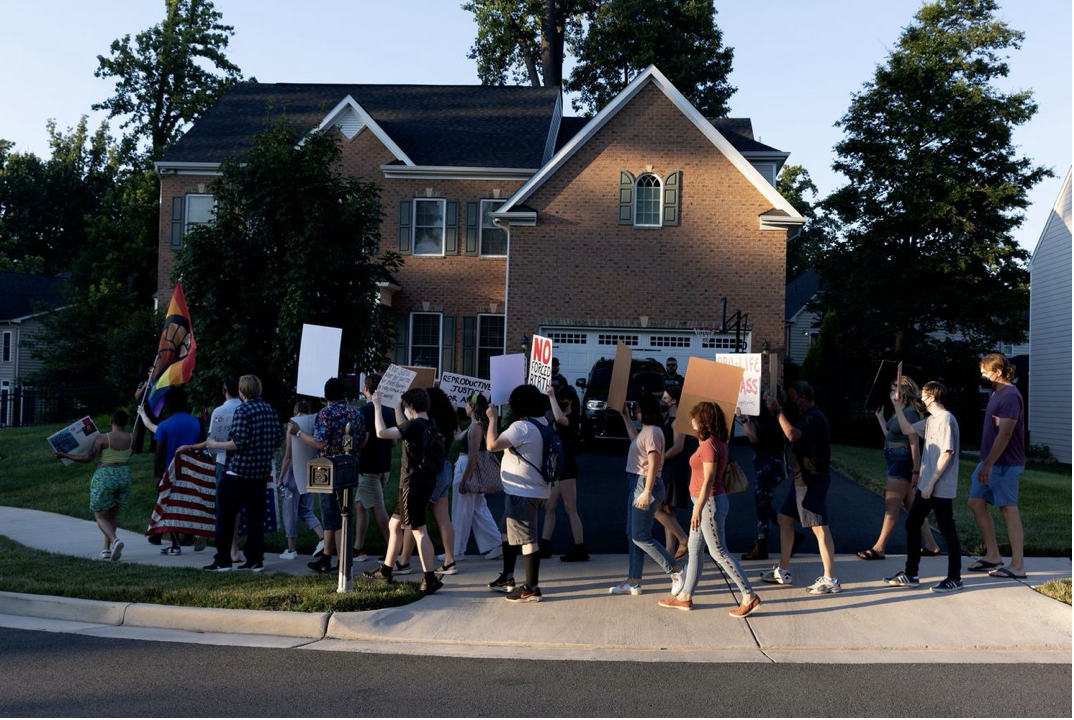When it comes to shielding Supreme Court Justices from intimidation by a mob, the buck apparently stops nowhere. Marshal of the Court Gail Curley has written to officials in Virginia and Maryland, warning that “protest activity at Justices’ homes, as well as threatening activity, has only increased.”
Virginia law bans picketing private residences or assembling to “disrupt any individual’s right to tranquility in his home.” Ms. Curley cites that statute in letters to Gov. Glenn Youngkin and Fairfax County. She says that last week dozens of protesters were outside the Justices’ homes, yelling “no privacy for us, no peace for you!” and chanting expletives. “This is exactly the kind of conduct that Virginia law prohibits,” Ms. Curley adds.
Maryland has a similar statute protecting residential peace, which she cites in a letter to Gov. Larry Hogan. To Montgomery County, Ms. Curley points out a local law that prohibits picketing “in front of or adjacent to any private residence.” It allows protests to march through neighborhoods “without stopping at any particular private residence.” But according to the marshal, crowds have lingered for up to 30 minutes at a time outside the Justices’ homes.
Why is nobody willing to deploy such laws against judicial intimidation? Officials have argued that Virginia’s and Maryland’s statutes are unenforceable, since they aren’t content neutral. Both laws have an exception that allows picketing for labor disputes. In a 1980 case (Carey v. Brown), the Supreme Court ruled 6-3 that a similar Illinois picketing ban was unconstitutional, since it had a union carve-out that “accords preferential treatment to the expression of views on one particular subject.”
Jeff McKay, chairman of the Fairfax County Board of Supervisors, said he thinks the Virginia statute quoted by Ms. Curley is unconstitutional. “The law cited in the letter is a likely violation of the First Amendment,” he said. “As long as individuals are assembling on public property and not blocking access to private residences, they are permitted to be there.”
Montgomery County’s local ban on residential picketing features no suspect union privilege. The High Court in Carey v. Brown said it did not intend to imply “that residential picketing is beyond the reach of uniform and nondiscriminatory regulation.” It added that a state’s interest in protecting the tranquility of private houses “is certainly of the highest order in a free and civilized society.”
Nevertheless, Montgomery County seems uninterested in enforcing its picketing rule. “We are following the law that provides security and respects the First Amendment rights of protesters,” said County Executive Marc Elrich. “It is noteworthy that the primary responsibility for the safety of the Supreme Court Justices and their families lies with the federal government.” The county didn’t offer a specific answer Tuesday when asked why, exactly, it isn’t enforcing its picketing ban.
As for the feds, where’s our invisible Attorney General Merrick Garland ? Federal law bans attempting to influence the courts by picketing the homes of judges. Govs. Youngkin and Hogan have asked Mr. Garland to act, quoting one Supreme Court protester as saying: “If you take away our choices, we will riot.” The Justice Department’s reply to Messrs. Youngkin and Hogan reads like a form letter to an annoying constituent.
Jeering outside the homes of public officials, some with young children, is a political escalation that Americans might soon regret. Virginia and Maryland, where many government bigwigs live, would be wise to shore up their laws by removing those defective labor exemptions. Montgomery County could try to enforce its ban, and Mr. Elrich might be surprised to find support from much of the public. Ditto for Mr. Garland. If not, they will bear some responsibility for the ugly precedent.
To see this article in its entirety and subscribe to others like it, choose to read more.
 Listen Online
Listen Online Watch Online
Watch Online Find a Station in Your Area
Find a Station in Your Area








 Listen Now
Listen Now Watch Online
Watch Online
